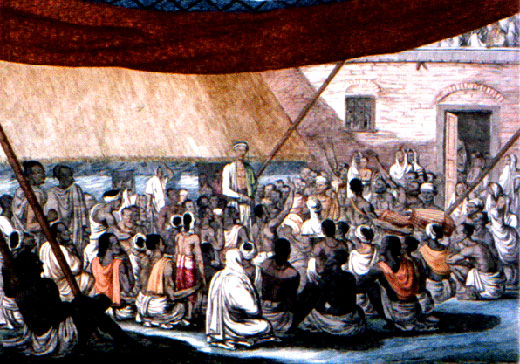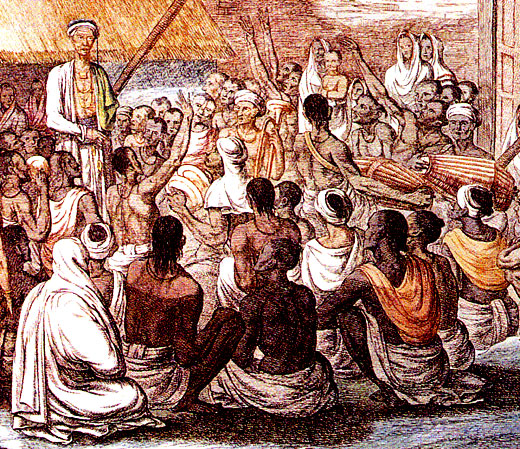From A Portrait of the Hindus: Balthazar Solvyns
& the European Image of India 1760-1824
More from Robert Hardgrave’s A Portrait of the Hindus: here is Balthazar Solvyns’s etching of a kirtan gathering in 18th century Calcutta. The term sankirtan – a compound of the Sanskrit words san (together), and kirtana (glorification) – refers to the practice of congregational singing of the holy names of God, especially in public, as a practice and expression of bhakti.
Above is a detail from the etching. The entire image can be found below. Again I’ve included an excerpt from the description by the artist, Balthazar Solvyns, and below that, an excerpt from Robert Hardgrave’s commentary, (I’ve not included the footnotes).
At the bottom of the post I’ve included links with more information about A Portrait of the Hindus. The images and text have been used with the kind permission of the book’s author Robert L. Hardgrave. Still more to come!
Kaustubha das
Paris: I.3.1. HURRY-SUNG-KERTUN. Recitation of the history and life of Hurry or Vestn: Hurry is the name given to Vestno incarnate for the conservation of the human race. Hurry-Sung-Kertun is that of a religious festival celebrated in honour of the god.
A Vestnub Brahmun recites the incarnation and the life of Hurry, whose loves are also the subject of his song. What relates to this latter part is repeated by other Vestnubs, to the sound of various instruments, the baunt, the mirdun and the kurtaul.
The Brahmun, who accompanies himself with the castagnettes, sings or declaims with vast expression: while, as his subject varies, the audience are rapt into ecstasy, dissolved in tears, or convulsed with laughter.
This festival, which is among those that attract the most followers, is celebrated towards the close of day, and sometimes later.
Commentary: Hari Sankirtan is “singing the praises of Hari”. Visnu embodies the principle of duration and is the preserver of the universe, and Hari is the name for Visnu as “Remover of Sorrow”. Sankirtan, or kirtan “consists of services of sacred song, either at a meeting or in a procession, often led by professional singers and accompanied by music, the assembled worshippers joining in chorus to glorify the god of their adoration and to chant his praises.” In emotional rapture, such devotional singing may last the whole night. In kirtan, celebrants often display ecstatic behavior, raising their arms in the air, as several persons do in Solvyn’s portrayal.
The tradition is associated with Caitanya (1485 – 1533), a Bengali saint who enjoined his followers to use kirtan – the repetitious singing of the names of god (Hari, Rama, Krsna) – in expression of their devotion.
In Bengal, O’Malley writes, “there are Vaishnava associations called Hari Sabhas, of which the object is spiritual development by means of bhakti or fervent love of God. Meetings are held once a week either in a building erected for the purpose or at the house of one of the members. Here the conception of a divine personality is brought home to the assembled people both by reading of sacred books and the singing of sacred songs. A Pandit is engaged to read and explain sacred books, and parties of singers are hired to sing hymns in honour of Vishnu in one or other of his incarnations. The worship is very different from that of temple services, where the priest is the sole celebrant and the people merely look on. It is also different from domestic worship, which is confined to the members of a family, for the meeting–house is a place where all may join in devotional exercises, and the worship is not that of separate individuals or families but of a united congregation.”
There is no one Hari Sankirtan festival. Rather, these celebrations are held irregularly and in scattered localities, where they are patronized by merchants or landowners. The duration of the Hari Sankirtan varies and may last for as long as a month.
In Solvyn’s portrayal, the kirtan takes place under a pandal, or tent, erected outside the house of a Hindu patron. The singer is accompanied by musical insruments – the bak, a trumpet (Pl.II.177); two mrdanga, drums (PL.II.158); and kartal (PL.II.171). The castanets to which Solvyns refers is the jhajhari (Pl.II.175). Such musicians often wandered the streets singing devotional songs.

Previous weblog entries on A Portrait of the Hindus here and here.
For information of the on the Solvyns Project click here.
To view Solvyns’ etchings online click here.
A Portrait of the Hindus can be purchased online.
